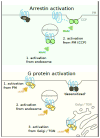Subcellular Organization of GPCR Signaling
- PMID: 29478570
- PMCID: PMC5830169
- DOI: 10.1016/j.tips.2017.11.009
Subcellular Organization of GPCR Signaling
Abstract
G protein-coupled receptors (GPCRs) comprise a large and diverse class of signal-transducing receptors that undergo dynamic and isoform-specific membrane trafficking. GPCRs thus have an inherent potential to initiate or regulate signaling reactions from multiple membrane locations. This review discusses emerging insights into the subcellular organization of GPCR function in mammalian cells, focusing on signaling transduced by heterotrimeric G proteins and β-arrestins. We summarize recent evidence indicating that GPCR-mediated activation of G proteins occurs not only from the plasma membrane (PM) but also from endosomes and Golgi membranes and that β-arrestin-dependent signaling can be transduced from the PM by β-arrestin trafficking to clathrin-coated pits (CCPs) after dissociation from a ligand-activated GPCR.
Keywords: G protein; GPCR; Golgi; arrestin; endosome; signaling.
Copyright © 2017 Elsevier Ltd. All rights reserved.
Conflict of interest statement
The authors declare no conflict of interest.
Figures


References
Publication types
MeSH terms
Substances
Grants and funding
LinkOut - more resources
Full Text Sources
Other Literature Sources

